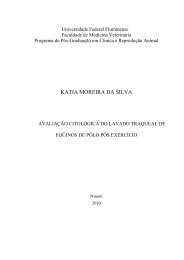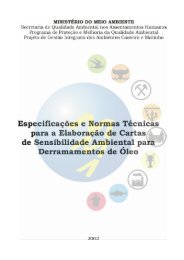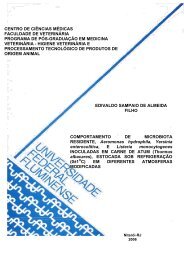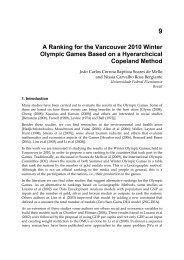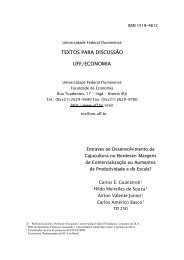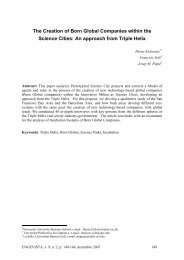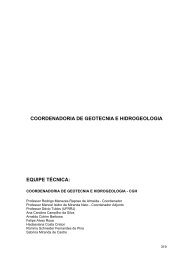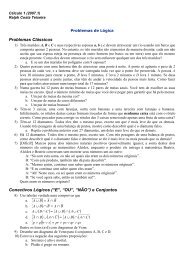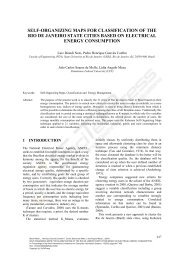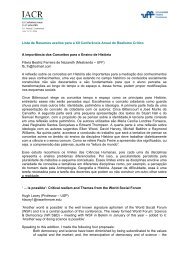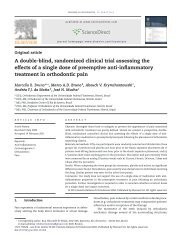Community structure of macrobenthos in two tropical sandy ... - UFF
Community structure of macrobenthos in two tropical sandy ... - UFF
Community structure of macrobenthos in two tropical sandy ... - UFF
Create successful ePaper yourself
Turn your PDF publications into a flip-book with our unique Google optimized e-Paper software.
Mar<strong>in</strong>e Ecology. ISSN 0173-9565<br />
ORIGINAL ARTICLE<br />
<strong>Community</strong> <strong>structure</strong> <strong>of</strong> <strong>macrobenthos</strong> <strong>in</strong> <strong>two</strong> <strong>tropical</strong><br />
<strong>sandy</strong> beaches with different morphodynamic features,<br />
Rio de Janeiro, Brazil<br />
Renata Soares Ramalho Fernandes 1 & Abilio Soares-Gomes 2<br />
1 Programa de Pós-Graduação em Biologia Mar<strong>in</strong>ha, Universidade Federal Flum<strong>in</strong>ense, Niterói, RJ, Brazil<br />
2 Departamento de Biologia Mar<strong>in</strong>ha, Universidade Federal Flum<strong>in</strong>ense, Niterói, RJ, Brazil<br />
Keywords<br />
Beach morphodynamic; community <strong>structure</strong>;<br />
<strong>in</strong>tertidal zonation; s<strong>of</strong>t-bottom benthos.<br />
Correspondence<br />
Renata Soares-Ramalho Fernandes, Programa<br />
de Pós-Graduação em Biologia Mar<strong>in</strong>ha,<br />
Universidade Federal Flum<strong>in</strong>ense, Caixa Postal<br />
100.644, Niterói, RJ – 24001-970, Brazil.<br />
E-mail: retfernandes2003@yahoo.com.br<br />
Accepted: 3 May 2006<br />
doi:10.1111/j.1439-0485.2006.00093.x<br />
Abstract<br />
The <strong>macrobenthos</strong> <strong>of</strong> <strong>two</strong> exposed <strong>tropical</strong> <strong>sandy</strong> beaches <strong>in</strong> Rio de Janeiro<br />
(Brazil) were compared <strong>in</strong> relation to density, species richness, and vertical<br />
zonation. Biological and sediment sampl<strong>in</strong>gs were carried out <strong>in</strong> the austral<br />
w<strong>in</strong>ter <strong>of</strong> 2002 and the austral summer <strong>of</strong> 2003. The sampl<strong>in</strong>g design consisted<br />
<strong>of</strong> 10 transects perpendicular to the water l<strong>in</strong>e, evenly divided <strong>in</strong>to strata. A<br />
sampl<strong>in</strong>g unit was taken <strong>in</strong> each stratum with a 0.04 m 2 quadrat sampler. Beaches<br />
were also compared accord<strong>in</strong>g to physical features, such as slope, wave<br />
period, wave height, and gra<strong>in</strong> size. Accord<strong>in</strong>g to Dean’s X morphodynamic<br />
<strong>in</strong>dex the Pontal is a dissipative beach while the Costa Azul is a reflective one.<br />
The mean gra<strong>in</strong> size ranged from median to coarse sand <strong>in</strong> Costa Azul,<br />
whereas <strong>in</strong> Pontal it ranged from median to very f<strong>in</strong>e sand. Eleven species were<br />
collected <strong>in</strong> the <strong>two</strong> beaches. Crustaceans were the dom<strong>in</strong>ant <strong>in</strong> the Costa Azul<br />
Beach, while the polychaete Scolelepis squamata dom<strong>in</strong>ated the Pontal beach. A<br />
negative correlation was found between the density <strong>of</strong> the <strong>macrobenthos</strong> and<br />
mean gra<strong>in</strong> size, and beach slope. On the other hand, the Dean’s parameter<br />
correlated positively with faunal density. Based on the results <strong>of</strong> ANOSIM, <strong>in</strong><br />
both beaches, <strong>two</strong> groups <strong>of</strong> stations were identified, def<strong>in</strong><strong>in</strong>g an upper and a<br />
lower beach zone along the vertical distribution <strong>of</strong> the <strong>macrobenthos</strong>.<br />
Problem<br />
Several environmental abiotic factors have been used to<br />
expla<strong>in</strong> variations <strong>in</strong> composition and abundance <strong>of</strong><br />
<strong>in</strong>tertidal <strong>macrobenthos</strong>, such as mean gra<strong>in</strong> size and<br />
sort<strong>in</strong>g <strong>of</strong> sediment gra<strong>in</strong>s, wave action, and dra<strong>in</strong>age <strong>of</strong><br />
the sediment column (Salvat 1964; McLachlan et al. 1981;<br />
Jaramillo & Gonzalez 1991). In relation to biotic factors,<br />
events related to the life cycle and <strong>in</strong>teractions among<br />
species (e.g. symbioses) could expla<strong>in</strong> some observed variations<br />
(Boesch 1973).<br />
The <strong>in</strong>teractions between tidal regime, wave climate,<br />
and sediment type produce a range <strong>of</strong> beach morphodynamic<br />
types, which span a cont<strong>in</strong>uum from microtidal<br />
reflective beaches, narrow and steep, to macrotidal dissipative<br />
systems, which are wide and flat, and under conditions<br />
<strong>of</strong> large tides, graded <strong>in</strong>to flats (Defeo & McLachlan<br />
2005).<br />
Ecological diversity, species richness, overall abundance,<br />
and biomass <strong>of</strong> macrobenthic communities <strong>in</strong>habit<strong>in</strong>g<br />
exposed <strong>sandy</strong> beaches present a clear <strong>in</strong>creas<strong>in</strong>g trend<br />
from reflective to dissipative conditions (McLachlan 1990;<br />
McLachlan et al. 1993).<br />
In oceanic beaches, where strong variation <strong>of</strong> abiotic<br />
variables are observed, physical factors are usually more<br />
important than biological ones <strong>in</strong> controll<strong>in</strong>g the community<br />
<strong>structure</strong> <strong>of</strong> <strong>in</strong>tertidal benthos. The morphodynamic<br />
state <strong>of</strong> the beaches reflects the harshness <strong>of</strong> these environments<br />
and could <strong>in</strong>dicate the k<strong>in</strong>d <strong>of</strong> fauna that<br />
colonize different beaches (Dexter 1983; Brown &<br />
160 Mar<strong>in</strong>e Ecology 27 (2006) 160–169 ª 2006 The Authors. Journal compilation ª 2006 Blackwell Publish<strong>in</strong>g Ltd
Fernandes & Soares-Gomes<br />
<strong>Community</strong> <strong>structure</strong> <strong>of</strong> <strong>macrobenthos</strong> <strong>in</strong> <strong>two</strong> <strong>tropical</strong> <strong>sandy</strong> beaches<br />
McLachlan 1990; Jaramillo & McLachlan 1993). Dissipative<br />
beaches are hydrodynamically more stable than<br />
reflective ones, harbor<strong>in</strong>g a more diverse fauna. The composition<br />
<strong>of</strong> these <strong>two</strong> types <strong>of</strong> beaches is quite different,<br />
with polychaetes be<strong>in</strong>g predom<strong>in</strong>ant <strong>in</strong> the dissipative<br />
beaches, and crustaceans be<strong>in</strong>g abundant <strong>in</strong> the reflective<br />
beaches (Dexter 1984; McLachlan et al. 1993).<br />
Although not so evident as <strong>in</strong> hard-bottoms, the fauna<br />
may exhibit a discrete distribution along the beach pr<strong>of</strong>ile<br />
<strong>in</strong> response to abiotic and biotic variables, form<strong>in</strong>g a typical<br />
zonation pattern worldwide (Dahl 1952; Salvat 1964).<br />
Zonation is highly dynamic and not sharply def<strong>in</strong>ed<br />
(Defeo & McLachlan 2005).<br />
The <strong>in</strong>fluence <strong>of</strong> beach morphodynamics and sediments<br />
on benthic communities and populations was studied,<br />
among others, by McLachlan (1990, 1996), Jaramillo &<br />
McLachlan (1993), McLachlan et al. (1993), Borzone<br />
et al. (1996), Bentes et al. (1997), Defeo et al. (1997,<br />
2001), Brazeiro (2001), Veloso & Cardoso (2001), Rodil<br />
& Lastra (2004). Only a few studies were carried out on<br />
the subtidal portion <strong>of</strong> the beach (Hill & Hunter 1976;<br />
Leber 1982; Knott et al. 1983; Borzone et al. 1996),<br />
because this required an <strong>in</strong>tensive and special sampl<strong>in</strong>g<br />
effort (Borzone et al. 1996).<br />
The ‘‘swash exclusion hypothesis’’ (SEH) ga<strong>in</strong>ed wide<br />
acceptability <strong>in</strong> expla<strong>in</strong><strong>in</strong>g the control <strong>of</strong> species, abundance<br />
and diversity <strong>of</strong> the <strong>sandy</strong> beach <strong>macrobenthos</strong> by<br />
swash climate, determ<strong>in</strong>ed by wave height and beach slope.<br />
This hypothesis predicts a consistent <strong>in</strong>crease <strong>in</strong> species<br />
richness, abundance and biomass from reflective to dissipative<br />
conditions (Defeo et al. 2001). It is hypothesized that<br />
only true <strong>in</strong>tertidal species will be affected by the differences<br />
<strong>in</strong> beach morphodynamic types (Contreras et al. 2003).<br />
Gómez & Defeo (1999) formulated new additions to the<br />
orig<strong>in</strong>al SEH (postulated at the community level), to<br />
account for predictions at the population level (reproductive<br />
sizes, fecundity, growth and mortality rates). They<br />
argued that <strong>in</strong> harsh reflective beaches, organisms would<br />
need to divert more energy to ma<strong>in</strong>tenance processes, rather<br />
than for reproductive growth (Defeo & Martínez 2003).<br />
The aim <strong>of</strong> this work was to verify if the above cited<br />
paradigms are true for <strong>two</strong> beaches at <strong>tropical</strong> latitudes and<br />
to describe the local vertical zonation <strong>of</strong> their fauna.<br />
Material and Methods<br />
Study area<br />
Both beaches studied (Rio de Janeiro, Brazil) are relatively<br />
free from anthropogenic impacts, except for human<br />
recreation, which is especially <strong>in</strong>tense on holidays and<br />
dur<strong>in</strong>g summer vacations. Praia do Pontal (22°57¢58¢¢ S)<br />
is a 700m long and 35m wide <strong>in</strong>tertidal beach, located <strong>in</strong><br />
BRASIL<br />
Arraial do Cabo Municipality, with a median to f<strong>in</strong>e sand<br />
granulometry. Costa Azul beach (22°31¢37¢¢) is a waveexposed,<br />
900m long and 50m wide <strong>in</strong>tertidal beach,<br />
located <strong>in</strong> Rio das Ostras Municipality, with a predom<strong>in</strong>ance<br />
<strong>of</strong> coarse sand (Fig. 1).<br />
Sampl<strong>in</strong>g design<br />
Sampl<strong>in</strong>g was carried out <strong>in</strong> the austral w<strong>in</strong>ter <strong>of</strong> 2002<br />
and the austral summer <strong>of</strong> 2003, dur<strong>in</strong>g low-spr<strong>in</strong>g tides.<br />
At each beach, <strong>two</strong> sectors (S1, S2), <strong>of</strong> 40 m distance,<br />
were sampled along five transects (T1–T5) perpendicular<br />
to the water l<strong>in</strong>e, from below the swash l<strong>in</strong>e and the<br />
supralittoral vegetation.<br />
Each transect was divided <strong>in</strong>to 10 strata, equally<br />
spaced, consistent with the follow<strong>in</strong>g beach width: Pontal<br />
beach width 35 m ¼ 3.5 m, the distance between the levels;<br />
Costa Azul Beach width 50 m ¼ 5 m, the distance<br />
between the levels.<br />
A sampl<strong>in</strong>g unit was taken <strong>in</strong> each stratum with a<br />
0.04 m 2 quadrat sampler, buried to a depth <strong>of</strong> 25 cm,<br />
and the <strong>macrobenthos</strong> were sorted us<strong>in</strong>g a 0.5mm-mesh<br />
sieve. To verify if some species occurred beyond the limits<br />
<strong>of</strong> the <strong>in</strong>tertidal zone, a triplicate sample was collected <strong>in</strong><br />
the break<strong>in</strong>g zone contiguous to each transect, with a<br />
mean depth <strong>of</strong> 2 m, us<strong>in</strong>g a hand corer <strong>of</strong> 0.00785 m 2 ,<br />
buried to a depth <strong>of</strong> 25 cm, and the <strong>macrobenthos</strong> were<br />
sorted us<strong>in</strong>g a 0.5mm-mesh sieve.<br />
As the sampl<strong>in</strong>g device used to sample the surf zone<br />
was different from the one used to sample the <strong>in</strong>tertidal<br />
zone, a comparison between both zones was not made.<br />
However, the surf zones <strong>of</strong> the <strong>two</strong> beaches were compared<br />
so as to test the differences.<br />
Habitat featur<strong>in</strong>g<br />
Rio de Janeiro<br />
45° 44° 43°W 42° 41°<br />
Fig. 1. Geographic location <strong>of</strong> the beaches studied.<br />
Costa Azul<br />
Pontal<br />
22°S<br />
The sediment samples for gra<strong>in</strong>-size analyses were collected<br />
at each stratum by <strong>in</strong>sert<strong>in</strong>g a 3.5cm diameter<br />
21°<br />
23°<br />
Mar<strong>in</strong>e Ecology 27 (2006) 160–169 ª 2006 The Authors. Journal compilation ª 2006 Blackwell Publish<strong>in</strong>g Ltd 161
<strong>Community</strong> <strong>structure</strong> <strong>of</strong> <strong>macrobenthos</strong> <strong>in</strong> <strong>two</strong> <strong>tropical</strong> <strong>sandy</strong> beaches<br />
Fernandes & Soares-Gomes<br />
cyl<strong>in</strong>drical corer to a depth <strong>of</strong> 15 cm. Samples were<br />
dried at 70 °C <strong>in</strong> an oven and sieved through graded<br />
screens so as to determ<strong>in</strong>e mean particle size and sort<strong>in</strong>g<br />
parameters (Folk & Ward 1957); the sediments were<br />
classified accord<strong>in</strong>g to the Wen<strong>two</strong>rth (1922) scale.<br />
Wave height was estimated by measur<strong>in</strong>g the height <strong>of</strong><br />
the waves with graduated poles aga<strong>in</strong>st the horizon.<br />
Beach slope at each site was determ<strong>in</strong>ed by Emery’s<br />
(1961) pr<strong>of</strong>il<strong>in</strong>g technique, from the average wave height<br />
(Hb), wave period (T) and sand fall velocity <strong>of</strong> the particles<br />
(values estimated us<strong>in</strong>g the mean gra<strong>in</strong> size from<br />
the swash zone and conversion tables given by Gibbs<br />
et al. 1971). Dimensionless Dean’s parameter (X) (Short<br />
& Wright 1983) was calculated for each beach as a<br />
measure <strong>of</strong> its morphodynamic state: X ¼ Hb/Ws · T.<br />
The wave period was the time <strong>in</strong>terval between breakers,<br />
and the swash period was estimated measur<strong>in</strong>g the<br />
maximum swash amplitude, calculated as the distance<br />
between the highest and the lowest turn<strong>in</strong>g po<strong>in</strong>ts <strong>of</strong><br />
the up-swash and back-swash, respectively, dur<strong>in</strong>g a 10-<br />
m<strong>in</strong> period.<br />
Data analysis<br />
The hypothesis that total <strong>macrobenthos</strong> density and species<br />
richness were different <strong>in</strong> the <strong>two</strong> sectors with<strong>in</strong> each<br />
beach was tested by the one-way ANOVA<br />
(T1 · T2 · T3 · T4 · T5). The a posteriori Tukey test<br />
was adopted to determ<strong>in</strong>e if there were significant differences<br />
among the transects. The one-way ANOVA was also<br />
adopted to test the differences between the sectors<br />
(S1 · S2).<br />
A Student’s t-test was used to compare the total<br />
abundance <strong>of</strong> sublittoral macr<strong>of</strong>auna between the beaches.<br />
All data were first tested for normality (Kolmogorov–<br />
Smirnov test) and homoscedasticity (Bartelett test) prior<br />
to all parametric analyses.<br />
The data set <strong>of</strong> each beach were arranged <strong>in</strong> an ecological<br />
matrix and analyzed by the Unweighted Pair<br />
Group Method, Average Cluster<strong>in</strong>g and Non-metric<br />
Multidimensional Scal<strong>in</strong>g Ord<strong>in</strong>ation Methods, adopt<strong>in</strong>g<br />
the Bray–Curtis similarity <strong>in</strong>dex. To test the hypothesis<br />
that the strata were different along the vertical distribution<br />
(levels, zonation), a one-way analysis <strong>of</strong> similarity<br />
(ANOSIM) was carried out us<strong>in</strong>g the Bray–Curtis similarity<br />
matrix.<br />
The samples were pooled for each level/stratum as the<br />
sum <strong>of</strong> the species abundance <strong>of</strong> the five transects for<br />
each stratum and sector, because the ANOVA results<br />
showed that there were no differences between the<br />
transects.<br />
The relationship between the abiotic and biotic variables<br />
was determ<strong>in</strong>ed by the Spearman rank correlation.<br />
Results<br />
Well-sorted f<strong>in</strong>e sands predom<strong>in</strong>ated at Pontal Beach<br />
while moderately sorted coarse sand was the ma<strong>in</strong> type <strong>of</strong><br />
sediment found at Costa Azul. Accord<strong>in</strong>g to the mean<br />
Dean’s X <strong>in</strong>dex, Pontal is a dissipative beach (X ¼<br />
6.120), and Costa Azul is a reflective beach (X ¼ 0.568).<br />
Table 1 shows the other abiotic features <strong>of</strong> the <strong>two</strong> sectors<br />
at each beach, separated by summer and w<strong>in</strong>ter surveys.<br />
Eleven species belong<strong>in</strong>g to crustaceans, molluscs, polychaetes<br />
and <strong>in</strong>sects were collected, four <strong>of</strong> which were<br />
common to both beaches. At each beach, a set <strong>of</strong> seven<br />
species was collected and some species were found only<br />
<strong>in</strong> one <strong>of</strong> the studied periods.<br />
In Pontal Beach, organisms were collected <strong>in</strong> all the 10<br />
levels analysed, while <strong>in</strong> Costa Azul, organisms were miss<strong>in</strong>g<br />
from levels 9 and 10.<br />
The polychaete Scolelepis squamata, the crustacean Excirolana<br />
armata and the <strong>in</strong>sect Phaleria testacea were found<br />
only at Pontal Beach; the latter species were found only<br />
<strong>in</strong> the w<strong>in</strong>ter survey. The polychaetes Pisionides <strong>in</strong>dica<br />
and Hemipodus olivieri, and the mollusc Olivancillaria vesica<br />
vesica occurred only at the Costa Azul Beach. Hemipodus<br />
olivieri was found only <strong>in</strong> w<strong>in</strong>ter and O. vesica<br />
vesica only <strong>in</strong> summer sampl<strong>in</strong>g.<br />
The dom<strong>in</strong>ant species at Pontal, on both surveys, was<br />
S. squamata while Excirolana braziliensis dom<strong>in</strong>ated at<br />
Costa Azul Beach. At Pontal E. armata co-dom<strong>in</strong>ated <strong>in</strong><br />
the w<strong>in</strong>ter survey and at Costa Azul, Donax hanleyanus<br />
co-dom<strong>in</strong>ated <strong>in</strong> w<strong>in</strong>ter, while Emerita brasiliensis<br />
Table 1. Physical characteristics <strong>of</strong> the beaches studied <strong>in</strong> w<strong>in</strong>ter (W)<br />
and summer (S).<br />
physical characteristics/<br />
beaches<br />
Pontal,<br />
sector 1<br />
Pontal,<br />
sector 2<br />
Costa Azul,<br />
sector 1<br />
Costa Azul,<br />
sector 2<br />
wave height [m]<br />
W 1.0 1.0 1.0 1.0<br />
S 1.0 1.0 0.8 0.8<br />
wave period [s]<br />
W 6.0 6.0 16.93 11.93<br />
S 5.8 5.8 10.2 10.2<br />
swash period [s]<br />
W 16.2 15.3 7.4 6.2<br />
S 14.1 14.5 7.3 7.2<br />
<strong>in</strong>tertidal slope [1/m]<br />
W 1:21.4 1:20 1:10.4 1:12.1<br />
S 1:22.5 1:20.8 1:12.1 1:15<br />
length [m]<br />
W 35 35 50 50<br />
S 35 25 50 50<br />
Dean parameter X<br />
W 6.01 6.01 0.48 0.51<br />
S 6.22 6.22 0.78 0.49<br />
162 Mar<strong>in</strong>e Ecology 27 (2006) 160–169 ª 2006 The Authors. Journal compilation ª 2006 Blackwell Publish<strong>in</strong>g Ltd
Fernandes & Soares-Gomes<br />
<strong>Community</strong> <strong>structure</strong> <strong>of</strong> <strong>macrobenthos</strong> <strong>in</strong> <strong>two</strong> <strong>tropical</strong> <strong>sandy</strong> beaches<br />
Table 2. The dom<strong>in</strong>ant species <strong>of</strong> the beaches studied <strong>in</strong> w<strong>in</strong>ter and<br />
summer.<br />
w<strong>in</strong>ter % summer %<br />
Pontal beach species<br />
Scolelepis squamata (Muller, 1806) 41.08 63.65<br />
Emerita brasiliensis (Schmitt, 1935) 21.40 17.37<br />
Excirolana armata (Dana, 1853) 32.37 13.37<br />
Excirolana braziliensis (Richardson, 1912) 4.25 4.62<br />
Donax hanleyanus (Philippi, 1842) 0.07 0.70<br />
Pseudorchestoidea brasiliensis (Dana, 1853) 0.55 0.28<br />
Phaleria testacea (Say, 1824) 0.27 –<br />
Costa Azul beach species<br />
Pisionides <strong>in</strong>dica (Aiyar & Alikunhi, 1940) 8.40 0.82<br />
Emerita brasiliensis (Schmitt, 1935) 20.15 30.23<br />
Donax hanleyanus (Philippi, 1842) 27.50 19.15<br />
Hemipodus olivieri (Orensanz &<br />
– 1.40<br />
Gianuca, 1974)<br />
Excirolana braziliensis (Richardson, 1912) 38.10 44.87<br />
Pseudorchestoidea brasiliensis (Dana, 1853) 5.30 3.56<br />
Olivancillaria vesica vesica (Gmel<strong>in</strong>, 1791) 0.36 –<br />
Table 4. Density <strong>of</strong> species [<strong>in</strong>d.Æm )2 ] and total number <strong>of</strong> <strong>in</strong>dividuals<br />
per beach, <strong>in</strong> w<strong>in</strong>ter (W) and summer (S).<br />
species PO, W PO, S C.A, W C.A, S<br />
Scolelepis squamata 3337.6 4602.5 – –<br />
Pisionides <strong>in</strong>dica – – 192.3 21.36<br />
Hemipodus olivieri – – – 29.91<br />
Emerita brasiliensis – – 192.3 200.85<br />
Donax hanleyanus – – 363.24 213.67<br />
Olivancillaria vesica vesica – – 68.37 –<br />
total faunal density 3337.6 4602.5 816.23 465.81<br />
total number <strong>of</strong> <strong>in</strong>d. 781 1077 191 109<br />
PO, Pontal Beach; CA, Costa Azul Beach.<br />
co-dom<strong>in</strong>ated <strong>in</strong> summer (Table 2). At Pontal Beach, the<br />
higher density <strong>of</strong> <strong>in</strong>tertidal <strong>in</strong>dividuals was found <strong>in</strong> the<br />
w<strong>in</strong>ter survey, and at Costa Azul the higher density was<br />
found <strong>in</strong> summer. However, at the break<strong>in</strong>g zone, the<br />
opposite pattern was observed with the higher density<br />
occurr<strong>in</strong>g <strong>in</strong> summer at Pontal Beach, and <strong>in</strong> w<strong>in</strong>ter at<br />
Costa Azul (Tables 3 and 4).<br />
Accord<strong>in</strong>g to the cluster and MDS analyses (Figs 2 and<br />
3) there were three groups <strong>of</strong> stations at Pontal and <strong>two</strong><br />
at Costa Azul. On the other hand, when apply<strong>in</strong>g the<br />
ANOSIM test, only <strong>two</strong> <strong>of</strong> these groups were statistically<br />
significant for both the beaches (global R ¼ 1.0).<br />
Compar<strong>in</strong>g the <strong>in</strong>tertidal zones, the Pontal Beach showed<br />
a higher species richness than Costa Azul. However, species<br />
richness at the break<strong>in</strong>g zone at the Costa Azul Beach<br />
Fig. 2. Cluster analysis and n-MDS ord<strong>in</strong>ations. Above: Pontal Beach<br />
w<strong>in</strong>ter; Below: Pontal Beach summer.<br />
Table 3. Density <strong>of</strong> species [<strong>in</strong>d.Æm )2 ], and total number <strong>of</strong> <strong>in</strong>dividuals per beach, <strong>in</strong> w<strong>in</strong>ter (W) and summer (S).<br />
species PO, W [m )1 ] PO, W [m )2 ] PO, S [m )1 ] PO, S [m )2 ] C.A, W [m )1 ] C.A, W [m )2 ] C.A, S [m )1 ] C.A, S [m )2 ]<br />
Scolelepis squamata 1636.6 3140 2651.2 4545 – – – –<br />
Pisionides <strong>in</strong>dica – – – – 1150 230 150 30<br />
Hemipodus olivieri – – – – 200 40 250 50<br />
Emerita brasiliensis 1150.6 1315 1446.6 1240 2550 550 5300 1105<br />
Excirolana braziliensis 259 370 288.7 330 4920 1040 795 1640<br />
Excirolana armata 2030 2400 1114.1 955 – – – –<br />
Pseudorchestoidea brasiliensis 70 40 87.5 50 500 115 416.6 130<br />
Ocypode quadrada – – – – 25 5 – –<br />
Donax hanleyanus 323.7 5 – – 3325 750 2950 700<br />
Olivancillaria vesica vesica – – – – 50 10 – –<br />
Phaleria testacea 35 20 70 20 – – – –<br />
total density 5504.9 7290 5658.1 7140 12720 2740 9861.6 3655<br />
total number <strong>of</strong> <strong>in</strong>d. 1458 1428 548 731<br />
PO, Pontal Beach; C.A, Costa Azul Beach.<br />
Mar<strong>in</strong>e Ecology 27 (2006) 160–169 ª 2006 The Authors. Journal compilation ª 2006 Blackwell Publish<strong>in</strong>g Ltd 163
<strong>Community</strong> <strong>structure</strong> <strong>of</strong> <strong>macrobenthos</strong> <strong>in</strong> <strong>two</strong> <strong>tropical</strong> <strong>sandy</strong> beaches<br />
Fernandes & Soares-Gomes<br />
stratum 8, at about 40 m from the water l<strong>in</strong>e. Accord<strong>in</strong>g<br />
to the ANOVA results, the density <strong>of</strong> E. braziliensis did<br />
not differ significantly between the sectors or periods<br />
(P > 0.05) (Fig. 4).<br />
Accord<strong>in</strong>g to the results from the Student’s t-test, the<br />
abundance <strong>of</strong> macrobenthic fauna was significantly different<br />
<strong>in</strong> the sublittoral zone between Pontal and Costa Azul<br />
(P < 0.05). At Pontal Beach, the macrobenthic fauna were<br />
more abundant <strong>in</strong> summer, whereas at Costa Azul they<br />
were more abundant <strong>in</strong> w<strong>in</strong>ter.<br />
The Spearman rank correlation analyses revealed a significant<br />
positive relationship between mean gra<strong>in</strong> size and<br />
beach slope (P < 0.005), and between omega (X) and<br />
macr<strong>of</strong>aunal density (P < 0.005). Conversely, significant<br />
negative correlations were found between mean gra<strong>in</strong> size<br />
and macr<strong>of</strong>aunal density (P < 0.005), and between beach<br />
slope and macr<strong>of</strong>auna density (P < 0.005) (Table 5).<br />
Discussion<br />
Fig. 3. Cluster analysis and n-MDS ord<strong>in</strong>ations. Above: Costa Azul<br />
beach w<strong>in</strong>ter. Below: Costa Azul Beach summer.<br />
was higher than at Pontal. At Costa Azul the species richness<br />
<strong>in</strong>creased from the higher to the lower <strong>in</strong>tertidal<br />
zone, while at Pontal, the higher species richness occurred<br />
at the <strong>in</strong>termediate levels (c. 23 m from the water l<strong>in</strong>e).<br />
On both beaches the total macrobenthic fauna did not<br />
differ significantly between <strong>in</strong>tra-sector transects (S1 –<br />
T1 · T2 · T3 · T4 · T5; P > 0.05) and (S2 – T1 · T2 ·<br />
T3 · T4 · T5; P > 0.05). Also, no significant differences<br />
were found between <strong>in</strong>ter-sectors (S1 · S2; P > 0.05) as<br />
well as between the <strong>two</strong> sampl<strong>in</strong>g periods (P > 0.05).<br />
At Pontal Beach, S. squamata occurred from the sublittoral<br />
zone to stratum 7, at approximately 24 m distance<br />
from the water l<strong>in</strong>e. The distribution <strong>of</strong> E. brasiliensis ranged<br />
from the sublittoral to stratum 5, peak<strong>in</strong>g at stratum<br />
4 (c. 14 m distance from the water l<strong>in</strong>e). Excirolana<br />
armata and E. braziliensis occurred from stratum 4 to<br />
stratum 7, and from stratum 5 to 10, respectively.<br />
Accord<strong>in</strong>g to the results from the ANOVA, the density <strong>of</strong><br />
S. squamata, E. brasiliensis and E. braziliensis did not differ<br />
between sectors or periods (Two-Way ANOVA factors<br />
sector and periods P > 0.05). The density <strong>of</strong> E. armata<br />
was higher <strong>in</strong> the w<strong>in</strong>ter (P < 0.05) but did not differ<br />
between sectors (P > 0.05).<br />
At Costa Azul, the highest density <strong>of</strong> E. brasiliensis<br />
occurred <strong>in</strong> stratum 1, at about 5 m distance from the<br />
water l<strong>in</strong>e. Donax hanleyanus ranged from strata 1 to 5,<br />
about 15 m above the water l<strong>in</strong>e. Its density was statistically<br />
different between the <strong>two</strong> sectors but did not differ<br />
between the seasons. Excirolana braziliensis occurred from<br />
stratum 2, at about 10-m distance from the water l<strong>in</strong>e, to<br />
Gra<strong>in</strong> size and swash period are the physical factors that<br />
control community <strong>structure</strong>. Gra<strong>in</strong> size <strong>of</strong>ten tends to be<br />
coarser at reflective rather than at dissipative beaches, as<br />
a result <strong>of</strong> <strong>in</strong>tense wave action <strong>in</strong> the former (McLachlan<br />
1990; Defeo et al. 1992; McArdle & McLachlan 1992;<br />
Borzone et al. 1996). The physical features <strong>of</strong> both beaches<br />
studied <strong>in</strong> this work are <strong>in</strong> accordance with these<br />
statements; the Pontal Beach has a slight slope and f<strong>in</strong>e<br />
gra<strong>in</strong>s, while the Costa Azul Beach has a steeper slope<br />
and coarser gra<strong>in</strong>s.<br />
Dexter (1983) and Borzone et al. (1996) showed that<br />
the density <strong>of</strong> the macr<strong>of</strong>auna was negatively correlated to<br />
mean gra<strong>in</strong> size. In addition, Defeo et al. (1992) found a<br />
negative correlation between beach slope and macr<strong>of</strong>aunal<br />
density, conclud<strong>in</strong>g that both slope and gra<strong>in</strong> size are<br />
factors determ<strong>in</strong><strong>in</strong>g beach macr<strong>of</strong>aunal <strong>structure</strong>. Accord<strong>in</strong>g<br />
to McLachlan (1990), the abundance <strong>of</strong> macr<strong>of</strong>auna is<br />
best correlated with Dean’s parameter. On the other hand,<br />
Jaramillo & McLachlan (1993) observed that gra<strong>in</strong> size<br />
was the sediment factor that best correlated with variations<br />
<strong>of</strong> macr<strong>of</strong>aunal abundance <strong>in</strong> Chilean beaches. For<br />
those beaches, slope, gra<strong>in</strong> size, and the Dean parameter<br />
were positively correlated with macr<strong>of</strong>aunal density.<br />
Some authors, when compar<strong>in</strong>g morphodynamic types,<br />
found an <strong>in</strong>crease <strong>in</strong> the abundance <strong>of</strong> macr<strong>of</strong>auna, from<br />
reflective to dissipative beaches (Brown & McLachlan<br />
1990; Defeo et al. 1992; Borzone et al. 1996; Brazeiro<br />
1999). Jaramillo et al. (2001) however, stated that the<br />
morphodynamics was not always a useful predictor <strong>of</strong><br />
<strong>sandy</strong> beach community <strong>structure</strong>.<br />
McArdle & McLachlan (1992) observed that variations<br />
<strong>in</strong> swash, a factor that is related to slope, lead to changes<br />
<strong>in</strong> the distribution <strong>of</strong> macr<strong>of</strong>auna. Accord<strong>in</strong>g to Bowman<br />
164 Mar<strong>in</strong>e Ecology 27 (2006) 160–169 ª 2006 The Authors. Journal compilation ª 2006 Blackwell Publish<strong>in</strong>g Ltd
Fernandes & Soares-Gomes<br />
<strong>Community</strong> <strong>structure</strong> <strong>of</strong> <strong>macrobenthos</strong> <strong>in</strong> <strong>two</strong> <strong>tropical</strong> <strong>sandy</strong> beaches<br />
Fig. 4. Variation <strong>in</strong> the number <strong>of</strong> <strong>in</strong>dividuals and slope along the water level.<br />
Table 5. Spearman Rank Correlation between abiotic and biotic variables<br />
<strong>of</strong> the beaches studied.<br />
variables R P significance<br />
gra<strong>in</strong> size versus faunal density )0.8982 0.0046 *<br />
gra<strong>in</strong> size versus <strong>in</strong>tertidal slope )0.7785 0.0279 *<br />
gra<strong>in</strong> size versus species richness 0.2191 0.6021 n.s.<br />
Intertidal slope versus faunal density 0.9048 0.0046 *<br />
Intertidal slope versus species richness 0.5361 0.1710 n.s.<br />
X versus density 0.8675 0.007 *<br />
X versus richness 0.3061 0.418 n.s.<br />
n.s., not significant.<br />
*P < 0.05.<br />
& Dolan (1985), beaches that have slight slopes and long<br />
swash periods are more favourable for filterfeed<strong>in</strong>g<br />
animals. The difference <strong>in</strong> the abundance <strong>of</strong> the<br />
<strong>sandy</strong> crab, E. brasiliensis between the beaches <strong>in</strong> this<br />
study, corroborates these ideas. The swash period at<br />
Pontal Beach was <strong>two</strong> times that at Costa Azul Beach,<br />
where the abundance <strong>of</strong> E. brasiliensis was very low, thus<br />
<strong>in</strong> agreement with the SEH, proposed by McLachlan et al.<br />
(1993).<br />
At Costa Azul Beach, where the animals were more<br />
exposed to wave action, crustaceans were the dom<strong>in</strong>ant<br />
taxa, whereas the polychaete S. squamata dom<strong>in</strong>ated at<br />
Mar<strong>in</strong>e Ecology 27 (2006) 160–169 ª 2006 The Authors. Journal compilation ª 2006 Blackwell Publish<strong>in</strong>g Ltd 165
<strong>Community</strong> <strong>structure</strong> <strong>of</strong> <strong>macrobenthos</strong> <strong>in</strong> <strong>two</strong> <strong>tropical</strong> <strong>sandy</strong> beaches<br />
Fernandes & Soares-Gomes<br />
Pontal Beach. Along the Brazilian coast, S. squamata<br />
occurs <strong>in</strong> beaches along São Paulo and Paraná State coasts<br />
(Amaral 1979; Amaral et al. 1990; Shimizu 1991, 1995;<br />
Omena & Amaral 1997), and it is the most characteristic<br />
macr<strong>of</strong>auna species, both <strong>in</strong> abundance and frequency<br />
(Souza & Gianuca 1995; Borzone et al. 1996). Similarly,<br />
Barros et al. (2001) found that S. squamata was the most<br />
representative species on a dissipative beach <strong>of</strong> the Paraná<br />
State coast, represent<strong>in</strong>g 70% <strong>of</strong> the total macr<strong>of</strong>auna<br />
abundance.<br />
Cirolanidae crustaceans were abundant at both the beaches<br />
studied. At Costa Azul, E. braziliensis was the most<br />
abundant species, and at Pontal, E. armata was the second<br />
most abundant species, coexist<strong>in</strong>g with the hippidean<br />
E. braziliensis. Defeo et al. (1997), compar<strong>in</strong>g the different<br />
beaches along the Uruguayan coast, concluded that<br />
E. braziliensis and E. armata prefer f<strong>in</strong>e <strong>sandy</strong> habitats,<br />
although E. braziliensis seems to be more eurytopic, also<br />
occurr<strong>in</strong>g at high densities <strong>in</strong> coarse <strong>sandy</strong> habitats. The<br />
lower abundance <strong>of</strong> E. braziliensis at Pontal Beach compared<br />
with Costa Azul might suggest a competitive <strong>in</strong>teraction<br />
with E. armata.<br />
Defeo et al. (2001), showed that E. brasiliensis was<br />
more abundant at dissipative beaches, corroborat<strong>in</strong>g the<br />
‘swash exclusion hypothesis’, which predicts a consistent<br />
<strong>in</strong>crease <strong>in</strong> species richness, abundance and biomass from<br />
reflective to dissipative conditions (Defeo et al. 2001).<br />
Conversely, it has been hypothesized that only true <strong>in</strong>tertidal<br />
species will be affected by differences <strong>in</strong> beach<br />
morphodynamic types (Contreras et al. 2003).<br />
In the present study, Pseudorchestoidea brasiliensis was<br />
found <strong>in</strong> both dissipative and reflective beaches. Gianuca<br />
(1983) has found that this crustacean was more abundant<br />
<strong>in</strong> dissipative beaches. On the other hand, it has been<br />
demonstrated that P. brasiliensis was more typical <strong>of</strong><br />
reflective beaches (Cardoso & Veloso 1996). Gómez &<br />
Defeo (1999) suggested that P. brasiliensis was more resistant<br />
to immersion, desiccation and least prone to predation<br />
at reflective beaches. These results show that this<br />
species is able to successfully colonize beaches that are<br />
morphodynamically dist<strong>in</strong>ct. However, <strong>in</strong> this study,<br />
P. brasiliensis was found at low densities at both the beaches<br />
studied. Barros et al. (2001) suggested that the<br />
absence <strong>of</strong> some species <strong>in</strong> the beaches could be associated<br />
with a high level <strong>of</strong> recreational activities (i.e. tramp<strong>in</strong>g)<br />
and the usual practice <strong>of</strong> removal <strong>of</strong> artificial and<br />
natural detritus from those beaches. Studies have shown<br />
that some species can be elim<strong>in</strong>ated or have their population<br />
densities reduced as a result <strong>of</strong> the <strong>in</strong>crease <strong>of</strong> recreational<br />
activities <strong>in</strong> beach ecosystems (M<strong>of</strong>fet et al. 1998).<br />
The total abundance and dom<strong>in</strong>ance <strong>of</strong> species were not<br />
different between w<strong>in</strong>ter and summer surveys. The same<br />
has been found <strong>in</strong> beaches along the Paraná State coast <strong>in</strong><br />
Southern Brazil, where crustaceans dom<strong>in</strong>ated or co-dom<strong>in</strong>ated<br />
together with polychaetes, regardless <strong>of</strong> the period<br />
(Barros et al. 2001). Therefore, the absence and/or the low<br />
abundance <strong>of</strong> some species can also be related to their life<br />
cycle. Monthly and annual fluctuations <strong>in</strong> population density<br />
are common among <strong>sandy</strong> beach macr<strong>of</strong>auna, where<br />
peaks <strong>in</strong> abundance are <strong>of</strong>ten a consequence <strong>of</strong> variations<br />
<strong>in</strong> recruitment rates (Souza & Gianuca 1995).<br />
Species richness <strong>in</strong> this study was low and similar to<br />
that recorded <strong>in</strong> the exposed Chilean beaches (Jaramillo<br />
et al. 2001), when compared with the west coast beaches<br />
<strong>of</strong> the United States, South Africa, Australia, and Oman.<br />
Otherwise, the macr<strong>of</strong>aunal density <strong>in</strong> the Chilean<br />
beaches is <strong>of</strong>ten higher than at other localities. Those high<br />
densities, <strong>in</strong> the majority <strong>of</strong> the cases studied, were largely<br />
a result <strong>of</strong> great densities <strong>of</strong> the sand crab Emerita<br />
analoga, that could reach 50% <strong>of</strong> the total density <strong>in</strong> the<br />
different types <strong>of</strong> beaches <strong>in</strong> Chile (Jaramillo & Lastra<br />
2001). Similar results have also been found by Dugan<br />
et al. (2000) along the California beaches. At Pontal<br />
Beach, densities were comparable with those <strong>of</strong> the Chile<br />
and California beaches, but are attributed to the high<br />
density <strong>of</strong> the polychaete S. squamata.<br />
Dahl (1952) and Salvat (1964), among others, have<br />
proposed a vertical zonation pattern for <strong>sandy</strong> beach<br />
assemblages. For Brown & McLachlan (1990) it was possible<br />
to recognize <strong>two</strong> vertical zones: a subaerial or resurgence<br />
zone and a subaquatic or retention zone. However,<br />
there are controversies about a global pattern <strong>of</strong> zonation<br />
<strong>in</strong> sedimentary beaches. Defeo et al. (1992) were not able<br />
to recognize a unique pattern for five beaches studied <strong>in</strong><br />
the coast <strong>of</strong> Uruguay. In addition Brazeiro & Defeo<br />
(1996) demonstrated that zonation at dissipative beaches<br />
could exhibit either a seasonal or a short-time variation.<br />
Beach species could have their distribution altered <strong>in</strong><br />
response to environmental changes such as beach width<br />
and slope, position <strong>of</strong> the swash zone, food availability,<br />
and competition (Brazeiro & Defeo 1996; Giménez &<br />
Yannicelli 1997).<br />
At Pontal Beach, our results po<strong>in</strong>ted out three groups<br />
<strong>of</strong> stations correspond<strong>in</strong>g to biological zones: a lower<br />
zone, where S. squamata was a conspicuous species, an<br />
<strong>in</strong>termediate zone, characterized by the high abundance<br />
<strong>of</strong> E. brasiliensis and E. armata, and a higher zone, where<br />
E. braziliensis was the characteristic species. At Costa<br />
Azul, only <strong>two</strong> zones could be dist<strong>in</strong>guished: a lower zone<br />
characterized by E. brasiliensis and D. hanleyanus, and a<br />
higher zone by E. braziliensis. When zonation patterns<br />
were tested us<strong>in</strong>g ANOSIM, only <strong>two</strong> zones were evident<br />
at both beaches; a zone located <strong>in</strong> the lower portion <strong>of</strong><br />
the beach, encompass<strong>in</strong>g <strong>in</strong>tertidal migratory species, and<br />
a zone where those migratory species were excluded.<br />
These results are <strong>in</strong> agreement with Brown & McLachlan<br />
166 Mar<strong>in</strong>e Ecology 27 (2006) 160–169 ª 2006 The Authors. Journal compilation ª 2006 Blackwell Publish<strong>in</strong>g Ltd
Fernandes & Soares-Gomes<br />
<strong>Community</strong> <strong>structure</strong> <strong>of</strong> <strong>macrobenthos</strong> <strong>in</strong> <strong>two</strong> <strong>tropical</strong> <strong>sandy</strong> beaches<br />
(1990), who suggested that the only valid zonation<br />
scheme might be a division <strong>of</strong> the air-breather, high-shore<br />
assemblages from the water-breather, lower shore assemblages.<br />
Giménez & Yannicelli (1997) suggested that on beaches<br />
with a steeper slope, E. brasiliensis and D. hanleyanus<br />
could def<strong>in</strong>e the zones more properly, while the high<br />
zone was characterized by E. braziliensis.<br />
Species that depend upon swash have their distribution<br />
limited to reflective beaches because on those beaches the<br />
slope is steeper and the swash is shorter. Correlation analysis<br />
between swash and slope suggested that slope controls<br />
zonation patterns on <strong>sandy</strong> beaches. At Costa Azul,<br />
the steep slope might act as a barrier h<strong>in</strong>der<strong>in</strong>g the migration<br />
<strong>of</strong> species that occupy the lower zone. As a result <strong>of</strong><br />
the fast water dra<strong>in</strong>age at the <strong>in</strong>termediate zone, only<br />
organisms adapted to dry sand such as E. braziliensis can<br />
persist.<br />
At Pontal Beach, P. brasiliensis and E. brasiliensis cooccur<br />
<strong>in</strong> the supralittoral zone. The occurrence <strong>of</strong> these<br />
cirolanid isopods at higher levels on the coast is opposite<br />
to the pattern proposed by Dahl (1952). The same occurrence<br />
was also reported by Jaramillo (1978), Gianuca<br />
(1983), Defeo et al. (1992) and Brazeiro & Defeo (1996)<br />
for temperate sites <strong>in</strong> South America.<br />
Defeo et al. (1997) studied the distribution <strong>of</strong> E. armata<br />
and E. braziliensis, and observed that when these species<br />
co-occur, E. braziliensis is found <strong>in</strong> lower densities and<br />
occupies the high mediolittoral zone, above the zone where<br />
E. armata occurs. The same was observed <strong>in</strong> the present<br />
study at Costa Azul.<br />
Few studies <strong>of</strong> beaches <strong>in</strong>clude samples taken <strong>in</strong> the<br />
sublittoral zone. Some studies showed that the sublittoral<br />
assemblages are more structurally variable than <strong>in</strong>tertidal<br />
ones (Borzone et al. 1996). Hill & Hunter (1976); Leber<br />
(1982) and Knott et al. (1983). In our study the results<br />
were contradictory. At Pontal, the density <strong>of</strong> S. squamata<br />
was higher <strong>in</strong> the sublittoral zone while the richness <strong>of</strong><br />
species was lower, while at Costa Azul, the species richness<br />
was higher <strong>in</strong> the sublittoral zone.<br />
Hill & Hunter (1976), Leber (1982) and Knott et al.<br />
(1983) concluded that species composition between the<br />
<strong>in</strong>tertidal and sublittoral zones differs. Contrary to those<br />
results, no exclusive species were found <strong>in</strong> the sublittoral<br />
zones at Costa Azul and Pontal.<br />
Fleischack & Freitas (1989) studied the sublittoral portion<br />
<strong>of</strong> several beaches and suggested an <strong>in</strong>verse relationship<br />
between species diversity and turbulence <strong>in</strong> the<br />
sublittoral zone. Barros et al. (2001) studied six beaches<br />
<strong>of</strong> the Paraná state coast (South Brazil), and found that<br />
higher values <strong>of</strong> species diversity occurred <strong>in</strong> a reflective<br />
beach. The same was found <strong>in</strong> our study, where the<br />
diversity was higher <strong>in</strong> the reflective beach <strong>of</strong> Costa Azul.<br />
The reflective beaches, be<strong>in</strong>g more stable, possibly also<br />
have more stable macr<strong>of</strong>aunal assemblages, but this test<br />
would need careful temporal sampl<strong>in</strong>g, consider<strong>in</strong>g the<br />
great variability <strong>in</strong> time and space <strong>of</strong> these environments<br />
(Barros et al. 2001).<br />
References<br />
Amaral A.C.Z. (1979) Ecologia e contribuição dos anelídeos<br />
poliquetos para a biomassa bêntica da zona das marés, no<br />
litoral norte do Estado de São Paulo. Boletim do Instituto<br />
Oceanográfico Press, São Paulo, 28, 1–52.<br />
Amaral A.C.Z., Morgado E.H., Lopes P.P., Belúcio L.F., Leite<br />
F.P.P., Ferreira C.P. (1990) Composition and distribution <strong>of</strong><br />
the <strong>in</strong>tertidal macr<strong>of</strong>auna <strong>of</strong> <strong>sandy</strong> beaches on São Paulo<br />
Coast. In: Anais do Simpósio de Ecossistemas da Costa Sul e<br />
Sudeste – Estrutura, Função e Manejo 2. ACIESP Press, São<br />
Paulo, 3, 258–279.<br />
Barros F., Borzone A.B., Sergio R. (2001) Macro<strong>in</strong>fauna <strong>of</strong> six<br />
beaches near Guaratuba Bay, Southern Brazil. Brazilian<br />
Archives Biology Technology, 44, 351–364.<br />
Bentes A.M.L., Fernandez G.B., Ribeiro A.Y. (1997) Estudo da<br />
morfod<strong>in</strong>âmica de praias compreendidas entre Saquarema e<br />
Macaé, RJ.Oecologia Brasiliensis, 3, 229–243.<br />
Boesch D.F. (1973) Classification and community <strong>structure</strong> <strong>of</strong><br />
<strong>macrobenthos</strong> <strong>in</strong> Hampton Roads Area, Virg<strong>in</strong>ia. Mar<strong>in</strong>e<br />
Biology, 21, 226–244.<br />
Borzone C.A., Souza J.R.B., Soares A.G. (1996) Morphodynamic<br />
<strong>in</strong>fluence on the <strong>structure</strong> <strong>of</strong> <strong>in</strong>ter and subtidal<br />
macr<strong>of</strong>aunal communities <strong>of</strong> sub<strong>tropical</strong> <strong>sandy</strong> beaches.<br />
Revista Chilena de Historia Natural, 69, 565–577.<br />
Bowman M.L., Dolan R. (1985) The relationship <strong>of</strong> Emerita<br />
talpoida to beach characteristics. Journal <strong>of</strong> Coastal Research,<br />
1, 151–163.<br />
Brazeiro A. (1999) Effects <strong>of</strong> harvest<strong>in</strong>g and density-dependence<br />
on the demography <strong>of</strong> <strong>sandy</strong> beach populations: the<br />
yellow clam Mesodesma mactroides <strong>of</strong> Uruguay. Mar<strong>in</strong>e Ecology<br />
Progress Series, 182, 127–135.<br />
Brazeiro A. (2001) Relationship between species richness and<br />
morphodynamics <strong>in</strong> <strong>sandy</strong> beaches: what are the underly<strong>in</strong>g<br />
factors. Mar<strong>in</strong>e Ecology Progress Series, 224, 35–44.<br />
Brazeiro A., Defeo O. (1996) Macro<strong>in</strong>fauna zonation <strong>in</strong> microtidal<br />
<strong>sandy</strong> beaches; is it possible to identify patterns <strong>in</strong><br />
such variable environments? Estuar<strong>in</strong>e, Coastal and Shelf Science,<br />
42, 523–536.<br />
Brown A.C., McLachlan A. (1990) Ecology <strong>of</strong> Sandy Shores.<br />
Elsevier Science Press, Amsterdam: 328 pp.<br />
Cardoso R.S., Veloso V.G. (1996) Population biology and<br />
secondary production <strong>of</strong> the sandhopper Pseudorchestoidea<br />
brasiliensis (Amphipoda: Talitridae) at Pra<strong>in</strong>ha Beach, Brazil.<br />
Mar<strong>in</strong>e Ecology Progress Series, 142, 111–119.<br />
Contreras H., Jaramillo E., Duarte C., McLachlan A. (2003)<br />
Population abundance, growth and natural mortality <strong>of</strong> the<br />
crustacean macro<strong>in</strong>fauna at <strong>two</strong> sand beach morphodynamic<br />
Mar<strong>in</strong>e Ecology 27 (2006) 160–169 ª 2006 The Authors. Journal compilation ª 2006 Blackwell Publish<strong>in</strong>g Ltd 167
<strong>Community</strong> <strong>structure</strong> <strong>of</strong> <strong>macrobenthos</strong> <strong>in</strong> <strong>two</strong> <strong>tropical</strong> <strong>sandy</strong> beaches<br />
Fernandes & Soares-Gomes<br />
types <strong>in</strong> southern Chile. Revista Chilena de Historia Natural,<br />
76, 543–561.<br />
Dahl E. (1952) Some aspects <strong>of</strong> the ecology and zonation <strong>of</strong><br />
the fauna on <strong>sandy</strong> beaches. Oikos, 4, 1–27.<br />
Defeo O., McLachlan A. (2005) Patterns, processes and<br />
regulatory mechanisms <strong>in</strong> <strong>sandy</strong> beach macr<strong>of</strong>auna: a multiscale<br />
analysis. Mar<strong>in</strong>e Ecology Progress Series, 295, 1–20.<br />
Defeo O., Martínez G. (2003) The habitat harshness hypothesis<br />
revisited: life history <strong>of</strong> the isopod Excirolana braziliensis <strong>in</strong><br />
<strong>sandy</strong> beaches with contrast<strong>in</strong>g morphodynamics. Journal <strong>of</strong><br />
the Mar<strong>in</strong>e Biological Association <strong>of</strong> the United K<strong>in</strong>gdom, 83,<br />
331–340.<br />
Defeo O., Jaramillo E., Lyonnet A. (1992) <strong>Community</strong> <strong>structure</strong><br />
and <strong>in</strong>tertidal zonation <strong>of</strong> the macro<strong>in</strong>fauna <strong>in</strong> the Atlantic<br />
coast <strong>of</strong> Uruguay. Journal Coastal Research, 8, 830–839.<br />
Defeo O., Brazeiro A., Alava A., Riestra G. (1997) Is <strong>sandy</strong><br />
beach macr<strong>of</strong>auna only physically controlled? Role <strong>of</strong> substrate<br />
and competition <strong>in</strong> isopods. Estuar<strong>in</strong>e, Coastal and<br />
Shelf Science, 45, 453–462.<br />
Defeo O., Gómez J., Lercari D. (2001) Test<strong>in</strong>g the swash exclusion<br />
hypothesis <strong>in</strong> <strong>sandy</strong> beach populations: the mole crab<br />
Emerita brasiliensis <strong>in</strong> Uruguay. Mar<strong>in</strong>e Ecology Progress Series,<br />
212, 159–170.<br />
Dexter D.M. (1983) <strong>Community</strong> <strong>structure</strong> <strong>of</strong> <strong>in</strong>tertidal <strong>sandy</strong><br />
beaches <strong>in</strong> New South Wales. Austrália. In: McLachlan A.,<br />
Erasmus T. (Eds), Sandy Beaches as Ecosystems. W. Junk,<br />
The Hague: 461–472.<br />
Dexter D.M. (1984) Temporal and spatial variability <strong>in</strong> the<br />
community <strong>structure</strong> <strong>of</strong> the fauna for four <strong>sandy</strong> beaches <strong>in</strong><br />
southeastern New South Wales. Journal <strong>of</strong> Mar<strong>in</strong>e and Freshwater<br />
Research, 5, 663–672.<br />
Dugan J.E., Hubbard D.M., Lastra M. (2000) Burrow<strong>in</strong>g abilities<br />
and swash behavior <strong>of</strong> three crabs, Emerita analoga<br />
Stimpson, Blepharipoda occidentalis Randall, and Lepidopa<br />
californica Efford (Anomura, Hippoidea), <strong>of</strong> exposed <strong>sandy</strong><br />
beaches. Journal <strong>of</strong> Experimental Mar<strong>in</strong>e Biology and Ecology,<br />
255, 229–245.<br />
Emery K.O. (1961) A simple method <strong>of</strong> measur<strong>in</strong>g beach<br />
pr<strong>of</strong>iles. Limnology and Oceanography, 6, 90–93.<br />
Fleischack P.C., Freitas A.J. (1989) Physical parameters <strong>in</strong>fluenc<strong>in</strong>g<br />
the zonation <strong>of</strong> surf zone benthos. Estuar<strong>in</strong>e, Coastal<br />
and Shelf Science, 28, 517–530.<br />
Folk R.L., Ward W.C. (1957) Brazos River bar, a study <strong>in</strong> significance<br />
<strong>of</strong> gra<strong>in</strong> size parameters. Journal <strong>of</strong> Sedimentary<br />
Petrology, 27, 3–26.<br />
Gianuca N.M. (1983) A prelim<strong>in</strong>ary account <strong>of</strong> the ecology <strong>of</strong><br />
<strong>sandy</strong> beaches <strong>in</strong> southern Brazil. In: McLachlan A., T.<br />
Erasmus (Eds), Sandy Beaches as Ecosystems. W. Junk, The<br />
Netherlands: 413–420.<br />
Gibbs R.J., Matthews M.D., L<strong>in</strong>k D.A. (1971) The relationship<br />
between sphere size and settl<strong>in</strong>g velocity. Journal <strong>of</strong> Sedimentary<br />
Petrology, 41, 7–18.<br />
Giménez L., Yannicelli B. (1997) Variability <strong>of</strong> zonation patterns<br />
<strong>in</strong> temperate microtidal Uruguayan beaches with different<br />
morphodynamic types. Mar<strong>in</strong>e Ecology Progress Series,<br />
182, 209–220.<br />
Gómez J., Defeo O. (1999) Life history <strong>of</strong> the sandhopper<br />
Pseudorchestoidea brasiliensis (Amphipoda) <strong>in</strong> <strong>sandy</strong> beaches<br />
with contrast<strong>in</strong>g morphodynamics. Mar<strong>in</strong>e Ecology Progress<br />
Series, 182, 209–220.<br />
Hill G.W., Hunter R.E. (1976) Interaction <strong>of</strong> biological and<br />
geological process <strong>in</strong> the beach and nearshore, northern<br />
Padre Island, Texas. In: Davis J.C., Eth<strong>in</strong>gton E. (Eds),<br />
Beach and Nearshore Sedimentation. Tulsa, Okla: 169–187.<br />
Jaramillo E. (1978) Zonacion y estructura de la comunidad<br />
macr<strong>of</strong>aunistica en playas de arena del sur de Chile (Mehu<strong>in</strong>,<br />
Valdivia). Studies Neo<strong>tropical</strong> Fauna Environment, 17,<br />
175–194.<br />
Jaramillo E., Gonzalez M. (1991) <strong>Community</strong> <strong>structure</strong> and<br />
zonation <strong>of</strong> the macro<strong>in</strong>fauna along a dissipative-reflective<br />
range <strong>of</strong> beach category <strong>in</strong> Southern Chile. Studies Neo<strong>tropical</strong><br />
Fauna Environment, 26, 193–212.<br />
Jaramillo E., Lastra M. (2001) Suspension feeders on <strong>sandy</strong><br />
beaches. In: Reise K. (Ed.), Ecological Comparisons <strong>of</strong> Sedimentary<br />
Shores. Spr<strong>in</strong>g – Verlag, Heidelberg. Ecological<br />
Studies, 151, 61–72.<br />
Jaramillo E., McLachlan A. (1993) <strong>Community</strong> and population<br />
responses <strong>of</strong> the macro<strong>in</strong>fauna to physical factors over a<br />
range <strong>of</strong> exposed <strong>sandy</strong> beaches <strong>in</strong> south-central Chile. Estuar<strong>in</strong>e,<br />
Coastal and Shelf Science, 37, 615–624.<br />
Jaramillo E., Contreras H., Duarte C., Quijón P. (2001)<br />
Relationships between community <strong>structure</strong> <strong>of</strong> the<br />
<strong>in</strong>tertidal macro<strong>in</strong>fauna and <strong>sandy</strong> beach characteristics<br />
along the Chilean coast. P.S.Z.N: Mar<strong>in</strong>e Ecology, 22(4),<br />
323–342.<br />
Knott D.M., Calder D.R., Van Dolah R.F. (1983) Macrobenthos<br />
<strong>of</strong> <strong>sandy</strong> beach and nearshore environments at Murrells<br />
Inlet. South Carol<strong>in</strong>a USA. Estuar<strong>in</strong>e, Coastal and Shelf<br />
Science, 16, 573–590.<br />
Leber K.M. (1982) Seasonality <strong>of</strong> macro<strong>in</strong>vertebrates on a temperate<br />
high wave energy <strong>sandy</strong> beach. Biological Mar<strong>in</strong>e<br />
Science, 32, 86–98.<br />
McArdle S.B., McLachlan A. (1992) Sand beach ecology: swash<br />
features relevant to the macr<strong>of</strong>auna. Journal Coastal<br />
Research, 8, 398–407.<br />
McLachlan A. (1990) Dissipative beaches and macr<strong>of</strong>auna<br />
communities on exposed <strong>in</strong>tertidal sands. Journal Coastal<br />
Research, 6, 57–71.<br />
McLachlan A. (1996) Physical factors <strong>in</strong> benthic ecology:<br />
effects <strong>of</strong> chang<strong>in</strong>g sand particle size on beach fauna. Mar<strong>in</strong>e<br />
Ecology Progress Series, 131, 205–221.<br />
McLachlan A., Dye A.H., Harty B. (1981) Simulation <strong>of</strong> the<br />
<strong>in</strong>terstitial system <strong>of</strong> exposed <strong>sandy</strong> beaches. Estuar<strong>in</strong>e, Coastal<br />
and Shelf Science, 12, 267–278.<br />
McLachlan A., Jaramillo E., Donn T.E., Wessels F. (1993)<br />
Sandy beach macr<strong>of</strong>auna communities and their control by<br />
the physical environment: a geographical comparison. Journal<br />
Coastal Research, 15(Special Issue), 27–38.<br />
168 Mar<strong>in</strong>e Ecology 27 (2006) 160–169 ª 2006 The Authors. Journal compilation ª 2006 Blackwell Publish<strong>in</strong>g Ltd
Fernandes & Soares-Gomes<br />
<strong>Community</strong> <strong>structure</strong> <strong>of</strong> <strong>macrobenthos</strong> <strong>in</strong> <strong>two</strong> <strong>tropical</strong> <strong>sandy</strong> beaches<br />
M<strong>of</strong>fet M.D., McLachlan A., W<strong>in</strong>ter P.E.D., De Ruyek A.M.C.<br />
(1998) Impact <strong>of</strong> trampl<strong>in</strong>g on <strong>sandy</strong> beach macr<strong>of</strong>auna.<br />
Journal Coastal Conservation, 4, 87–90.<br />
Omena E.P., Amaral A.C.Z. (1997) Distribuição espacial de<br />
Polychaeta (Annelida) em diferentes ambiente sentremarés<br />
de praias de São Sebastião (SP). In: Absalão R., Esteves<br />
A.M. (Eds) Oecologia Braziliensis. Ecologia de Praias Arenosas<br />
do Litoral Brasileiro, III, 183–196.<br />
Rodil I.F., Lastra M. (2004) Environmental factors affect<strong>in</strong>g<br />
benthic macr<strong>of</strong>auna along a gradient <strong>of</strong> <strong>in</strong>termediate <strong>sandy</strong><br />
beaches <strong>in</strong> northern Spa<strong>in</strong>. Estuar<strong>in</strong>e, Coastal and Shelf Science,<br />
61, 37–44.<br />
Salvat B. (1964) Les conditions hydrodynamiques <strong>in</strong>tertitielles<br />
des sédiment meubles <strong>in</strong>tertidaux et la repartition verticale<br />
de la jemme endogée. Comptes Rendus Academie Sciences<br />
Paris, 256, 1576–1579.<br />
Shimizu R.M. (1991) A comunidade de macro<strong>in</strong>vertebrados da<br />
região entre marés da Praia de Barequeçaba, São Sebastião,<br />
São Paulo. MSc thesis, Universidade de São Paulo, São<br />
Paulo: 72 pp.<br />
Shimizu R.M. (1995) Influência de um derramamento de óleo<br />
numa espécie dom<strong>in</strong>ante de fauna de praias arenosas no<br />
litoral paulista. In: Anais: IX Simpósio de Recursos Hídricos/II<br />
Simpósio de Hidráulica e Recursos Hídricos dos Países de Língua<br />
Oficial Portuguesa. ABRH/ UFPE, Recife, 4: 399–404.<br />
Short A.D., Wright L.D. (1983) Physical variability <strong>of</strong> <strong>sandy</strong><br />
beaches. In: McLachlan A., Erasmus T. (Eds), Sandy Beaches<br />
as Ecosystems. W. Junk Publishers, The Netherlands: 133–<br />
144.<br />
Souza J.R.B., Gianuca N.M. (1995) Zonation and seasonal<br />
variation <strong>of</strong> the <strong>in</strong>tertidal macr<strong>of</strong>auna on a <strong>sandy</strong> beach <strong>of</strong><br />
Paraná State, Brazil. Scientia Mar<strong>in</strong>a, 59, 103–111.<br />
Veloso V.G., Cardoso R.S. (2001) The effect <strong>of</strong> morphodynamics<br />
on the spatial and temporal variation <strong>of</strong> the macr<strong>of</strong>auna<br />
<strong>of</strong> three <strong>sandy</strong> beaches on the Rio de Janeiro State, Brazil.<br />
Journal <strong>of</strong> the Mar<strong>in</strong>e Biological Association <strong>of</strong> the United<br />
K<strong>in</strong>gdom, 81, 369–375.<br />
Wen<strong>two</strong>rth C.H. (1922) A scale <strong>of</strong> grade and class terms for<br />
clastic sediments. Journal Geological, 30, 377–392.<br />
Mar<strong>in</strong>e Ecology 27 (2006) 160–169 ª 2006 The Authors. Journal compilation ª 2006 Blackwell Publish<strong>in</strong>g Ltd 169



